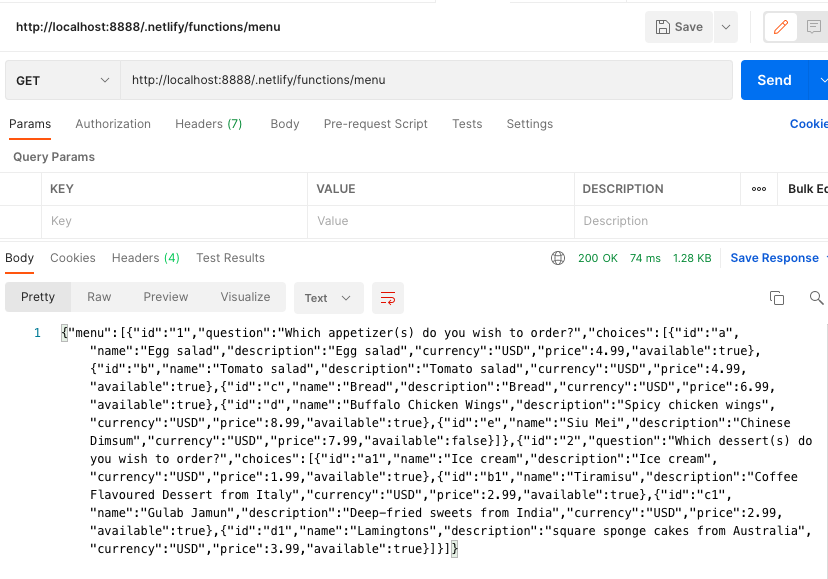![]()
Introduction
I created a container component, FoodMenuComponent, to display a menu for users to order food and drink.
There are several ways to create the menu data in JSON format:
- Hardcoded data in the component
- Create static JSON data in assets folder and use a service to retrieve the data for the component
- Design a backend API and use a service to call the endpoint to retrieve the data
- Add a serverless function to return the menu data to the component
Option 1 makes component bloated because it contains both business logic and data. Business logic and data should belong to service and external data source respectively.
Option 2 is ideal for Angular beginners such that they don’t have to worry about backend design and implementation.
Option 3 requires developers to have knowledge of one or more backend frameworks, for example, Express and NestJS. Because of the additional skills, it demands more development efforts for a simple side project.
After weighing all alernatives, I chose Netlify function because I can leverage backend capability of cloud provider instead of building my own backend server.
Result
This is the end result of FoodMenuComponent

The menu asks two questions and each question has at least one choice for user to choose.
Let me show you how to create a Netlify function to return menu data that FoodMenuComponent consumes and displays on browser.
Install Netlify CLI
Firstly, we have to install Netlify CLI globally.
npm install netlify-cli -gCreate Netlify function Configuration
Secondly, we create netlify.toml that is the configuration file of Netlify. Add the following sections to toml file:
[build]
publish = "dist/ng-spanish-menu"
command = "ng build"
functions = "./src/assets/functions"
[[redirects]]
from = "/*"
to = "/index.html"
status = 200and the most important line is functions = "./assets/functions".
functions = "./assets/functions" specifies the folder of Netlify functions and all functions should save to it.
Then, start Netlify CLI with Angular in development mode
ntl devand open the application at http://localhost:8888
Setting up First Severless Function
Thirdly, we define our first serverless function to return menu data. We can find the function in ./assets/functions/menu.ts.
// menu.ts
import { Handler } from "@netlify/functions";
const data = {
"menu": [
{
"id": "1",
"question": "Which appetizer(s) do you wish to order?",
"choices": [
{
"id": "a",
"name": "Egg salad",
"description": "Egg salad",
"currency": "USD",
"price": 4.99,
"available": true
},
... omitted for the sake of brevity ...
]
},
{
"id": "2",
"question": "Which dessert(s) do you wish to order?",
"choices": [
{
"id": "a1",
"name": "Ice cream",
"description": "Ice cream",
"currency": "USD",
"price": 1.99,
"available": true
},
... omitted for the sake of brevity ...
]
}
]
}
const handler: Handler = async () => {
return {
statusCode: 200,
body: JSON.stringify(data),
};
};
export { handler };Testing Severless Function
Next, we launch Postman application to test the GET endpoint to verify it is working as expected.
Get Endpoint: http://localhost:8888/.netlify/functions/menu

If the request is successful, the response displays menu data.
Adding endpoint in Angular
Lastly. open environment.ts and add a new environment variable, menuUrl, to it. Next, we will create food service to retrieve menu data through this endpoint.
export const environment = {
production: false,
menuUrl: '/.netlify/functions/menu',
}Creating food service
@Injectable({
providedIn: 'root',
})
export class FoodService {
constructor(private http: HttpClient) {}
getFood(url: string): Observable<MenuItem[] | undefined> {
return this.http.get<Menu>(url).pipe(
pluck('menu'),
catchError((err: Error) => {
console.error(err)
return of(undefined)
}),
share(),
)
}
}getFood function requests menu data from our serverless function and returns the result as Observable<MenuItem[] | undefined>. When request fails, we return undefined since menu does not exist.
Calling service in Angular component with RxJS
Lastly, FoodMenuComponent can combine RxJS operators and food service to retrieve menu data and assign to Observable<Menu[] | undefined>.
@Component({
selector: 'app-food-menu',
templateUrl: './food-menu.component.html',
changeDetection: ChangeDetectionStrategy.OnPush,
})
export class FoodMenuComponent implements OnInit, OnDestroy {
menuItems$: Observable<MenuItem[] | undefined>
ngOnInit(): void {
this.menuItems$ = this.service
.getFood(environment.menuUrl)
.pipe(takeUntil(this.unsubscribe$))
}
menumItemTrackByFn(index: number, menuItem: MenuItem): string | number {
return menuItem ? menuItem.id : index
}
choiceTrackByFn(index: number, choice: Choice) {
return choice ? choice.id : index
}
... Omitted for the sake of brevity ....
}In the template of FoodMenuComponent, async pipe resolves menuItems$ into MenuItem array (menuItems) and Angular provides ngFor directive that can iterate an array to render values in each row.
<div class="container" *ngIf="menuItems$ | async as menuItems; else notAvailable">
<app-food-menu-card *ngFor="let menuItem of menuItems; index as i; trackBy: menumItemTrackByFn">
<app-food-question [question]="menuItem.question" head></app-food-question>
<ng-container *ngFor="let choice of menuItem.choices; index as j; trackBy: choiceTrackByFn" body>
<app-food-choice [choice]="choice" (foodChoiceAdded)="handleFoodChoice.emit($event)"></app-food-choice>
</ng-container>
</app-food-menu-card>
</div>
<ng-template #notAvailable>No menu</ng-template>The container div iterates menuItems and passes each menuItem to <app-food-menu-card> element. Each menuItem has one question and each question displays some options for user to select. <app-food-question> is responsible for rendering menu item question and <app-food-choice> renders all available and unavailable options of the question.
We have reached the end of the post and FoodMenuComponent is working. You should see the same component that I showed at the beginning of the post.

We are finally at the end of the post! I hope you find this article useful and leverage serverless function in your Angular . Good bye!
Resources:


